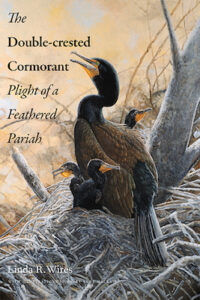In bird watching, there are certain species that are casually referred to as “invisible;” not because they’re difficult to see, but because they’re either so commonly seen or of such little interest to most observers as to go unnoticed. Both the American Robin and the American Crow fall into this category, as does the Rock Pigeon. For those doing a good bit of their bird watching near water, the Double-crested Cormorant often also becomes “invisible” – or if noticed, often only in passing and with some disappointment due to it being mistaken for a more “desirable” bird such as a loon or a grebe.
For many fishermen and commercial aquaculturists (fish farmers) however, the Double-crested Cormorant is all too visible – as well as too plentiful. Being one of if not the most effective of all the fish-eating birds inhabiting North America, the Double-crested Cormorant is the very bane of their existence; a malevolent creature worthy of being fought at any opportunity and by any means necessary. Yet somewhere between invisible and infernal lies the reality of this, in truth, unusual and fascinating bird – and it is this very truth that conservation biologist Linda R. Wires seeks to explain to the reading public through her very enlightening book The Double-Crested Cormorant: Plight of a Feathered Pariah.
Regardless of how much you know (or what you may think you know) about Double-crested Cormorants, cormorants in general, or even the much larger subjects of ecology and conservation, Ms. Wires’ book will open your eyes to a host of new and interesting information about all these subjects. Beginning with one of the most thorough and nuanced overviews of a species that it has ever been my pleasure to read, she not only explains (in very eloquent yet clear language that is well-suited to the non-specialist reader) what is presently known about the life history of the Double-crested Cormorant but also digs deep into the pre- as well the historic past to explain not just what was once thought about cormorants but why such ideas were held. For in truth, the natural history of the cormorant in general and the Double-crested Cormorant in particular is a history not only of the bird itself but of its tightly interwoven relationship with human beings.
Following the threads of not only natural history but simultaneously conservation and legislative history as well, Ms. Wires delves deep into what could easily (and in many other unrelated works on these latter two subjects all-too-often does) become very dry material and recounts the pertinent events with both vitality and style so as to make even the history and effects of such otherwise-seemingly arcane bits of legislation as the First and Second Standing Depredation Orders as compelling to read as a first-rate novel. Indeed, even if one is not particularly interested in the Double-crested Cormorant itself, Ms. Wires’ explanation of North American wildlife conservation and management history itself is well-worth the price of the book.
Finally, it would be a grievous wrong indeed in any review of this book to overlook mentioning its superb black and white illustrations by Barry Kent MacKay. Depicting significant behaviors as well as simply scenes from the life cycle of the Double-crested Cormorant, Mr. MacKay’s images are every bit as important to the overall strength of the book as Ms. Wires’ expansive knowledge of her subject and her superb skill in unfolding that knowledge to her readers are. It is impossible to imagine that anyone having once read this brilliant book will ever look at a Double-crested Cormorant the same way again – and it is sincerely hopes that enough people will read it so as to change for the better the way in which they are seen by the society as a whole.
 Title: The Double-Crested Cormorant: Plight of a Feathered Pariah
Title: The Double-Crested Cormorant: Plight of a Feathered Pariah
Author: Linda R. Wires; original illustrations by Barry Kent MacKay
Publisher: Yale University Press
Format: Cloth
Pages: 368 pp with 33 b/w illus.
ISBN: 9780300187113
Date: Apr 29, 2014
In accordance with Federal Trade Commission 16 CFR Part 255, it is disclosed that the copy of the book read in order to produce this review was provided gratis to the reviewer by the publisher.
